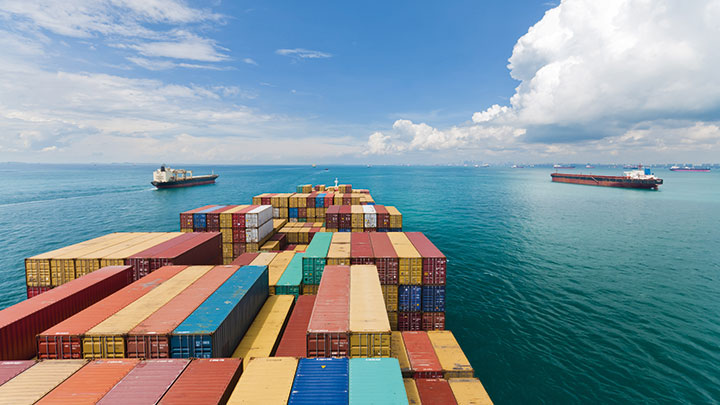Four scenarios for CO2-neutral shipping
The goal is clear: by 2050, shipping must halve its CO2 emissions. In a joint study, MAN Energy Solutions and the Fraunhofer Institute have developed four scenarios that point towards what the shipping industry could look like in 2050.
It’s 2020 and the elephant in the room is Covid-19. "If the pandemic has taught us one thing, it is that change is inevitable. Things that we previously thought of as completely self-evident have changed virtually overnight." Dr. Jonathan Köhler's perfect German is tinged with an unmistakable British accent. "And we must also be prepared for this in terms of climate. “Even if the pandemic currently weighs heavily on world affairs, everyone must be aware that climate change continues regardless,” warns Köhler. In this respect, he says that the shipping industry in particular must not lose sight of decarbonization.
Köhler is not only the mastermind behind the #AHOY2050 study commissioned by MAN Energy Solutions, which outlines four potential, future scenarios for global shipping, he is also a real all-rounder. As a naval architect, he has worked for the British Ministry of Defence and in large ship development – and found the time to add a PhD in economics from the University of Cambridge – while as an expert in climate and energy policy, he is currently a researcher at the Fraunhofer Institute for Systems and Innovation Research, ISI. In other words: who better to take a look at what shipping might look like in 2050?

Jonathan Köhler, PhD, is the mastermind behind #AHOY2050.
If the IMO's goals are to be achieved by 2050, we absolutely must start acting today
.jpg?sfvrsn=7fed1d02_0)
International trade is growing – while emissions need to be reduced. How can this dilemma be solved?
MAN Energy Solutions commissioned a study from the Fraunhofer Institute in mid-2019 on the future of the shipping industry. The research team, led by Jonathan Köhler, then spent several months devising various, future scenarios.
The challenge is that while emissions are expected to fall across the maritime industry, international trade is growing and – with it – global shipping traffic. By 2050, the IMO expects the industry to grow by 50-250%. "So it comes down to one crucial question: how do we reconcile lower emissions and greater growth?” says Köhler. "If the IMO's goals are to be achieved by 2050, we absolutely must start acting today. The aim of our study is therefore to show the industry possible courses of action and their ramifications".
#AHOY2050: a study from and for the industry

“Successful decarbonization depends on the majority of the world population supporting a sustainable lifestyle. Fridays for Future must get back on the streets − as soon as possible”, says MAN CEO Uwe Lauber.
A commitment to sustainable maritime solutions for the future is part of MAN Energy Solutions’ corporate strategy. The company has driven the Maritime Energy Transition forward since 2016 and – with the publication of the #AHOY2050 study –
is once again showing how seriously it takes the project.
"With #AHOY2050, we want to give food for thought and stimulate discussion. We have been driving the idea of a Maritime Energy Transition for many years and, against the backdrop of the pandemic, the need to decarbonize may seem less pressing. It is not!
This especially applies to the shipping industry where the average product-lifecycle is 30 years and over. In our industry, 2050 is just one ship-generation away,” comments Dr. Uwe Lauber, CEO of MAN Energy Solutions.
#AHOY2050 looks at shipping, not as an isolated industry but as one element of a global ecosystem. Hence, researchers considered a wide range of economical, societal and political factors whose development directly affects that of the shipping industry.
This includes peoples’ attitudes to life and consumer awareness, general economic development, oil prices, regulations and the global trend of digitization. "The inclusion of such variables makes the study really valuable. It is thus not simply
another series of purely mathematical equations in a social vacuum, rather it is the combination of market, scientific and social factors that makes the study and its assumptions applicable,” says Köhler.
In our industry, 2050 is just one ship-generation away
Working together with more than 40 experts from industry, politics and science, Köhler’s team identified 13 critical factors that will influence decarbonization. These resulted in four scenarios that cast a glance into the future. (see here).
“For MAN Energy Solutions, it was very important to include the perspectives of the entire shipping industry. When the first four scenario drafts were developed, we talked to various experts and needed to know whether our assumptions were plausible
from their point of view. Had we missed something? Where did we need to sharpen up?” says Köhler.
The final scenarios are entitled: ‘All on Board’, ‘Hanging on to Old Ways’, ‘Out of Control’ and ‘Yes We Can?’.
Two are based on the assumption that climate targets will be met or even exceeded by 2050, while the other two assume failure. “Scenarios A and Y show that global regulations for reducing environmental impacts have the potential to drive massive, technological change in shipping, and that such regulation is heavily driven by public opinion. In contrast, scenarios H and O show that, left to its own devices, technological development is more likely to focus on maximizing efficiency and driving down costs. There would still be a switch to LNG and, accordingly, some reduction in emissions, but the switch to renewable fuels will simply not happen unless the world makes a conscious decision to drive this," predicts Köhler.
Is a strict ban of fossil fuels required?
“Mapping scenarios is not about predicting the future,” says Lauber, "but they can offer some guidance and help to identify trends or point in a general direction. Probably the most disruptive action suggested by the scenarios is that, from a certain point on, we may have to consider a complete ban on fossil fuels in shipping. Such a step is a striking parallel between both scenarios in which climate goals are achieved”.
Furthermore, public pressure from society is – in all scenarios – an essential lever for the implementation or lack of decisive regulation. “Regulation is the enabler for change. It is largely driven, however, by public opinion,” adds Lauber. “Successful decarbonization depends on the majority of the world population supporting a sustainable lifestyle. Fridays for Future must get back on the streets − as soon as possible”.
The #AHOY2050 scenarios also suggest – if everyone works together – that decarbonization could become a growth engine for shipping. “In a global-growth scenario that is consistently geared towards climate protection, ships can play out their advantages over other means of transport," says Lauber. “In this respect, the range of cost-efficient and applicable technologies for reducing emissions is much broader than, for example, with air transport”.

Shipping has the chance to become the most environmental-friendly way of transportation since the range of cost-efficient and applicable technologies for reducing emissions is much broader than with air transport.
#AHOY2050
#AHOY2050 introduces four different scenarios, each with a very different outcome in regard to the industry’s future, technological development and GHG mitigation efforts.
Download the study
- to learn more about four different scenarions on what the shipping industry might look like in 2050
- get some valuable insights for a better understanding and decision making
Explore more topics
MAN Energy Solutions is now Everllence.
We have adopted a new brand name and moved to a new domain: www.everllence.com. This page will also be relocated there shortly. We are working on shifting all pages to www.everllence.com.
